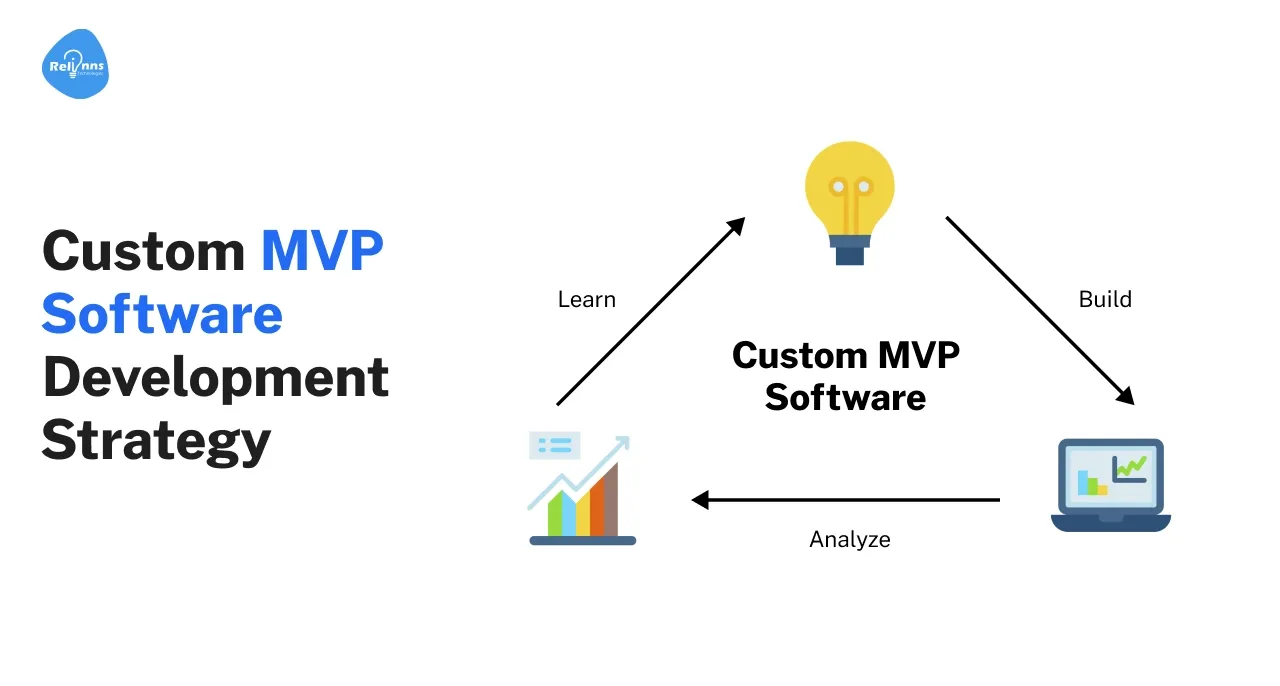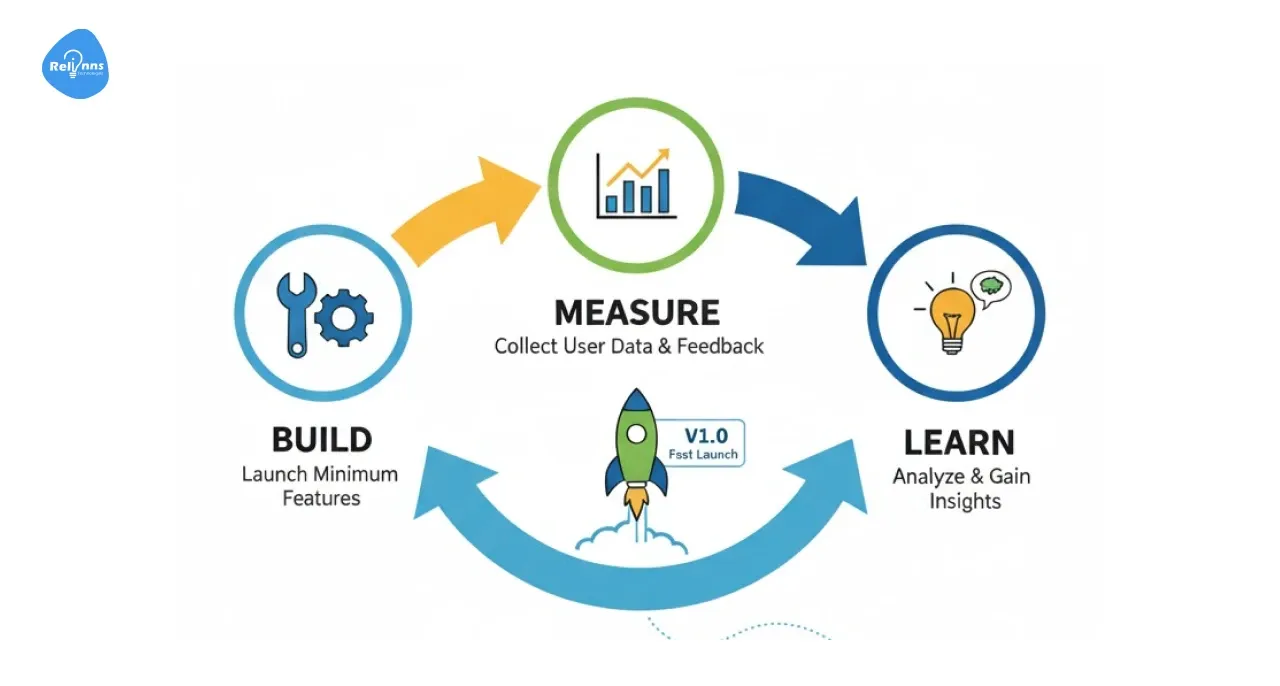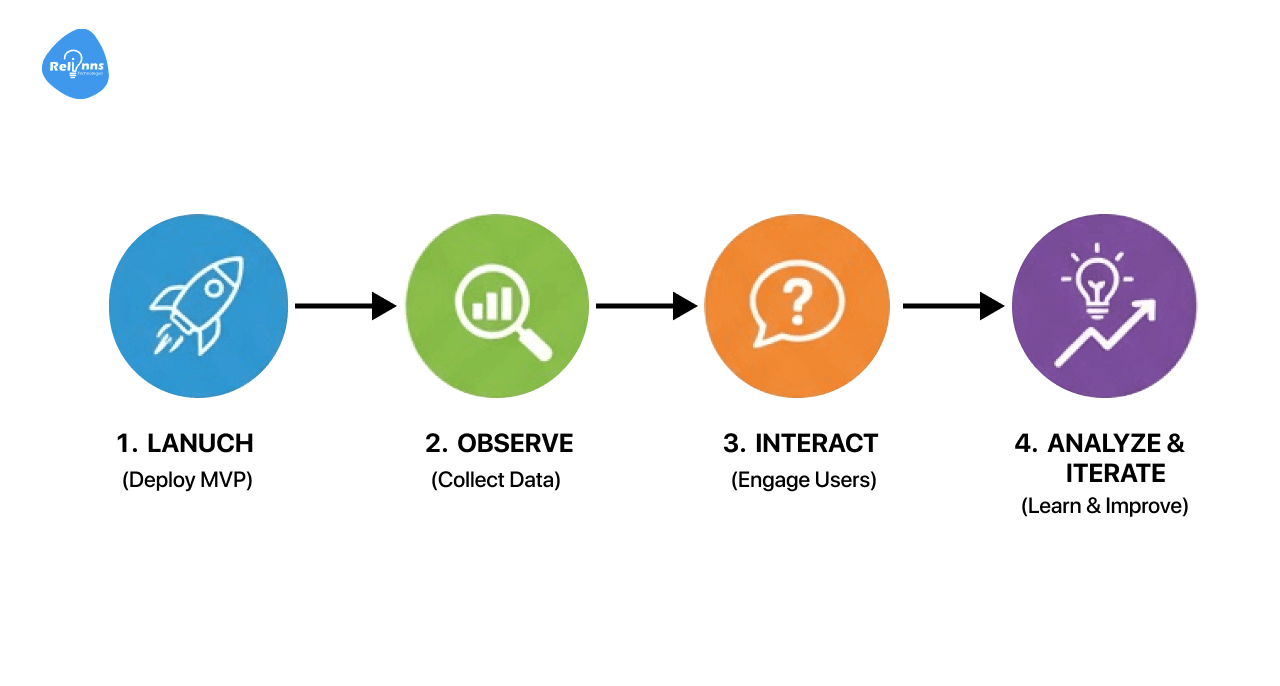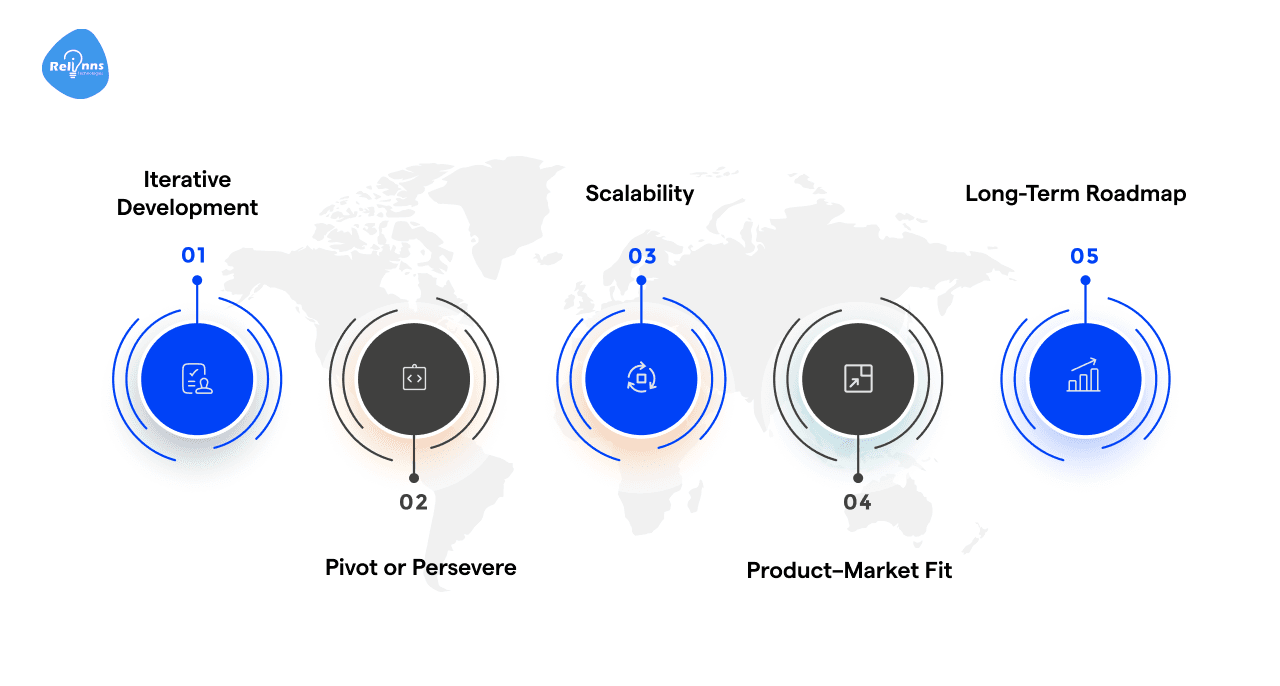Custom MVP Software Development Strategy
Date
Nov 04, 25
Reading Time
9 Minutes
Category
Custom development

A Custom MVP Software Development Strategy focuses on testing core ideas with minimum effort before full-scale launch. A well-planned MVP (Minimum Viable Product) project validates assumptions and refines the product vision.
This guide covers how to build an MVP step by step. We address key questions such as how much it costs to build an MVP, how long it takes to build an MVP, and customer development MVP practices.
Our strategy framework covers defining the problem, prioritizing features, choosing low-code tools, rapid prototyping, user testing, and data-driven iteration.
By integrating lean startup principles, each Custom MVP Software Development Strategy helps ensure your product aligns with real user needs and product–market fit.
What is a good MVP strategy?

A good MVP strategy starts with clear goals and assumptions. Experts emphasize defining your customer development MVP approach up front: “What problem are you solving, and how will success be measured?”
This involves identifying target users and their pain points. A solid strategy will be rooted in a strong product vision but remain flexible. Using Lean Startup principles, teams iterate in short build–measure–learn cycles, gathering user feedback at each stage.
An MVP should focus on core value while conserving resources.
In practice, you set specific success metrics (user adoption, engagement, etc.) and design an MVP to test those hypotheses.
By combining lean planning with product–market fit goals, a robust Custom MVP Software Development Strategy saves time and money while learning what truly matters to users.
Here are the Custom MVP Software Development Strategies
Below are six key strategy questions that detail how to build and refine an MVP. Each section includes a real-world case study to provide context.
1. What Problem are you solving, and who are your Users?
Start by clearly defining the problem and target audience. Conduct user research or interviews to understand needs.
Create user personas and map their journey. A focused custom MVP software development strategy keeps scope minimal and addresses a specific use case or pain point.
For example, ask early on, “If our MVP solves this problem, what change do we expect in user behavior?” Align the product vision and success metrics accordingly.
- Analyze competitor products and market gaps.
- Clarify the value proposition for users.
- Set concrete goals (signups, retention rates) to measure
Use Case: Airbnb
Problem: Expensive, scarce short-term lodging; travelers needed easier ways to find affordable accommodations. Hosts had extra space but no platform.
Solution: Airbnb’s founders created a simple website MVP listing their own apartment (air mattresses) during a conference. They solved the lodging problem by connecting hosts and guests with minimal features (photos, booking form).
Results
- 200 million+ users worldwide
- 8 million active listings across 220+ countries
- Hosts earned over $250 billion in revenue
- 1 billion+ total nights booked on the platform
Source: Airbnb news release and DemandsAge reports.
2. How do you identify and prioritize essential MVP features?
With the problem and users defined, list all potential features. Then prioritize ruthlessly. Use models like MoSCoW (Must, Should, Could, Won’t) to classify features.
Focus only on must-haves that directly solve the core problem. Techniques include the following.
- Feature prioritization matrix: score features by user value vs development cost, choosing high-value, low-cost items first.
- User Story Mapping: arrange user tasks in sequence to identify necessary steps and cut extras.
- Kano Model: distinguish delight features from basic expectations, delaying “nice-to-haves”.
The goal is a feature set that is minimal yet valuable. Each chosen feature should answer “Why does the user need this?” and “How does it validate our idea?” Effective feature prioritization avoids wasting effort on low-impact functions.
Use Case: Buffer
Problem: Social media users needed an easy way to schedule posts (queue tweets) without the hassle of manual scheduling.
Solution: Buffer launched with a very limited MVP: a two-page site to validate demand. Founder Joel Gascoigne tweeted a sign-up link for a future scheduling app. Early users provided feedback by requesting invites and sharing their email addresses. Only core scheduling functionality was planned initially.
Results
- 500+ users within 2 months
- ~4% of users converted to paid plans
- 65,819 customers today (buffer.com)
- Monthly active users ~187,141
Source: Buffer blog and transparency dashboard.
3. Which Low-code or No-code Platform suits your MVP Goals?
Choosing the right development approach can accelerate your MVP timeline. Evaluate low-code/no-code platforms if speed and budget are critical.
Such platforms (e.g., Joget, Bubble, Glide, FlutterFlow) provide visual tools and reusable components, enabling rapid prototyping.
Low-code is ideal for building a custom MVP when you need quick validation.
- Assess required functionality: e.g., forms, workflows, mobile vs web.
- Check integration needs: Does the platform easily connect to needed APIs or databases?
- Consider team skills: low-code allows non-developers to participate (business analysts, designers)
- Review scalability: some platforms (e.g., VSoft archITekt) have built-in security and scaling features.
For example, low-code MVPs often complete prototyping much faster, saving on development time and costs. They also facilitate agile adjustments as user feedback comes in.
Ultimately, pick the platform that meets your tech, timeline, and scalability needs.
Suggested Reading: Joget vs Bubble for App Development: A Strategic Comparison
Use Case: MedoPlus (by Relinns Technologies)
Problem: MedoPlus, a healthcare platform serving rural and semi-urban markets, struggled with fragmented service access, long queues, and outdated appointment systems that could not scale with rising demand.
Solution: Relinns Technologies built a comprehensive digital platform using Node.js and MongoDB on AWS. It included web and mobile apps with Razorpay and UPI integration, appointment scheduling (video, call, walk-in), and pharmacy storefronts, all tailored to underserved communities.
Results
- 280,000+ patients registered in the early rollout phase
- 157,000+ appointments processed digitally
- 10 million+ rural residents connected via the platform
- 35% users adopted remote consultations (video/audio)
- 200+ clinics onboarded within the first 6 months
Source: Read more about it at Relinns.
4. How do you design, Prototype, and launch your MVP quickly?
Focus on speed and learning. Start by sketching wireframes or mockups to visualize user flows. Low-fidelity wireframes (on paper or digital) help refine the UI early. Key steps include the following.
- User flows: Map the most straightforward path that achieves the MVP’s goal.
- Wireframing: Create basic screens (wireframes) of core interactions. This validates the design before coding.
- Prototype: Build a clickable or code prototype to test with real users. Tools like Figma or InVision let you create interactive demos without backend code.
- Usability testing: Get feedback on the prototype. Ask users to perform tasks and observe pain points. Iterate on UI based on this feedback.
- Lean Iteration: As Figma advises, conduct build–measure–learn cycles. Keep the prototype minimal and use actual data (metrics) to guide improvements.
Good design practices speed up the launch of an MVP. For instance, using standard UI components and focusing on essential features avoids lengthy custom design.
After initial user tests, refine only the top-priority screens. The aim is to launch a working MVP quickly to gather real-world data.
Suggested Reading: Best Software Development Methodologies
Use Case: BarEssay
Problem: Law students faced inefficiency in studying for the bar exam. Traditional methods gave no personalized feedback on essays. Students wasted hours on unfocused study.
Solution: Built on Bubble in just 4 weeks, BarEssay is an AI-driven learning platform. Users write practice essays on the app. An AI engine instantly analyzes legal accuracy and writing style, then highlights weaknesses. The MVP interface was clean and exam-like, focusing only on essay feedback and recommendations. Rapid prototyping (Bubble) allowed this advanced solution to be developed in record time.
Results
- Students studied 30% less time due to targeted learning.
70% more efficient at identifying weak areas - Increased exam confidence and scores (measurable improvement)
- Demonstrated MVP viability, leading to further development of advanced writing tools
5. How Will You Validate Your MVP and Gather User Feedback?

Once your MVP is live (even to a small audience), focus on learning. The goal is to validate hypotheses and refine product–market fit.
- Usability Testing: Invite real users to try the MVP and observe their behavior. Use surveys and interviews to capture qualitative feedback on ease of use and usefulness.
- Analytics: Track in-product metrics (clicks, feature usage, completion rates). Figma’s guide stresses that you need in-app metrics to decide what works. For example, count how often a feature is used or where users drop off.
- A/B Tests: Try variations of key elements (e.g., onboarding flows or feature placements) to see what increases engagement.
- Feedback Loops: Encourage feedback channels. Quickly respond to user suggestions or issues. Every cycle of customer development MVP involves listening to user input and iterating.
It’s crucial to remain flexible. The Lean Startup build–measure–learn loop means you “iterate based on data, not guesses”.
If feedback indicates a missing feature is critical, add it; if a feature is unused, consider cutting it.
Proper validation occurs when metrics improve and users show signs of product–market fit (e.g., higher retention, referrals, or conversions).
Use Case: Dropbox
Problem: Sharing files across devices was cumbersome. The founders needed to know if people actually wanted seamless file syncing before building it.
Solution: Dropbox’s team produced an MVP in the form of a simple explainer video rather than a complete app. The video clearly demonstrated the benefits of file sync for users. It went viral on tech forums and captured attention without a working backend.
Results
- 70,000 sign-ups overnight after the video launch
- Provided massive demand, guiding product development
- Today: 700+ million registered users
- 18.2 million paid subscribers (2025)
- $2.55 billion revenue in 2024
Source: YansMedia and Backlinko.
6. What is Your Plan for Iterating and Scaling Your MVP Based on Data?

After validation, plan your product's evolution. An MVP strategy must include iterative development and scalability considerations. Apply these steps.
- Iterative Development: Continue multiple Build–Measure–Learn loops. Adjust features based on collected data. Add high-demand features or improve UI elements that caused friction.
- Pivot or Persevere: Use user data to decide whether to pivot (change direction) or persevere. If core assumptions are invalid, pivot to a new approach.
- Scalability: As usage grows, ensure your architecture and platform can scale. For custom MVPs, plan refactoring or migration before major bottlenecks appear.
- Product–Market Fit: Pursue metrics such as engagement and retention. The goal is steady growth and satisfaction.
- Long-Term Roadmap: Once core features are validated, plan for more advanced functionality. Use priority metrics to guide what to build next.
A Custom MVP Software Development Strategy with a solid iteration plan turns initial learning into growth.
A data-driven approach ensures every new feature or scale-up is justified by real user needs, not assumptions.
Use Case: RentFund
Problem: Rental payments were outdated. Tenants got no benefits for paying rent, and managers wasted hours on manual verification.
Solution: RentFund built an MVP rewards platform (using Glide). Tenants automatically earned cash-back on rent payments, and the app handled verification with minimal input. The simple MVP included only core payment-tracking and reward features.
Results
- Raised investor interest, achieving a $3.0 million valuation
- 50% reduction in manual payment processing time
- Accelerated tenant onboarding and rewards (renters see real benefits)
- Proved market demand for a modern rental fintech solution
Source: RentFund case study.
Start Building Your Custom MVP Software Development With Relinns
Relinns offers the expertise and tools to turn your strategy into action. Using the Relinns Joget low-code platform, you can boost team productivity and build custom MVPs faster.
The platform’s visual workflow builder and rapid deployment features help cross-functional teams collaborate on design, prototyping, and iteration.
Boost Team Productivity Using Relinns' Joget Platform – Relinns’ Joget platform lets you launch MVP projects in weeks, not months. By empowering business users and developers to work together, you save costs and accelerate the MVP development process without sacrificing quality.
Contact Relinns Today For Expert Joget Support – Our consultants guide you through every step of your Custom MVP Software Development Strategy. From initial planning to user testing, Relinns provides ongoing support so you can focus on product growth rather than technical hurdles.
Conclusion: Build Smart, Launch Fast with Custom MVP Software
A Custom MVP Software Development Strategy streamlines the path from idea to validated product.
By asking the right questions – What problem are we solving? And who are our users? – and following a lean, data-driven process, teams can focus on core value and achieve product–market fit.
We’ve outlined strategies for defining scope, prioritizing features, choosing rapid development platforms, prototyping with wireframes, validating with user feedback, and iterating with metrics.
Real-world examples (Airbnb, Dropbox, Buffer, etc.) show that even the most successful companies began as humble MVPs.
In practice, always measure the cost of building an MVP against the learning value it provides. Similarly, set realistic timelines (e.g., the time required to make an MVP) and use iterative development to refine features.
With Relinns’ support and tools, your team can execute this strategy efficiently. The key is to launch fast, learn fast, and iterate toward a scalable product that users love.
Frequently Asked Questions (FAQ's)
What is the MVP approach in software development?
The MVP (Minimum Viable Product) approach builds a basic product version with core features to validate ideas early. It helps reduce cost, gather user feedback, and guide future development based on real-world market demand.
How to create an MVP plan?
To create an MVP plan, define your target audience, key problems, and core features. Use tools like wireframes and prioritize essentials. Choose fast development platforms, test early, and iterate using honest feedback and analytics insights.
What is an example of a famous MVP?
Dropbox launched with only a demo video explaining its concept. This simple MVP drew 70,000+ early sign-ups, validating demand before full development. Other famous MVPs include Airbnb and Buffer, which started with minimal yet functional prototypes.
Is Flutter a framework or a language?
Flutter is a cross-platform UI framework, not a programming language. It uses Dart as its coding language and allows developers to build mobile, web, and desktop apps from a single codebase with native-like performance and UI consistency.


